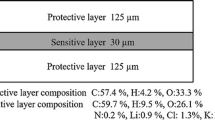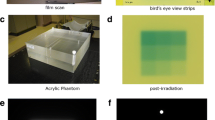Background and Purpose:
In one entire intensity-modulated radiation therapy (IMRT) plan, beams coming from different directions have different penetration depths in the phantom. Therefore, verifying an entire IMRT plan with a calibration curve for a single depth is error-prone. The aim of this study is to improve the quality of the dose verification of entire IMRT plans with film dosimetry.
Material and Methods:
The dose response of the Kodak EDR2 film to 6-MV photon beams was investigated in a solid-water phantom for different field sizes and depths. A method is proposed for evaluating measurements of the optical density with a calibration curve that takes the response at different depths into account. The described method was tested for three entire IMRT plans. For this purpose, calculated and measured dose distributions were compared, where the measured dose distribution was evaluated using a calibration curve for one depth (5 cm) and a calibration curve derived according to the proposed method.
Results:
All measurements suggest that the dose response significantly depends on the depth in the phantom, while dependencies on field size and off-axes distance are smaller. For tested plans, gamma index < 1 (using 3 mm distance and 3% dose as constrains) was reached for 81% and 91% of the points for one plan (prostate), 81% and 86% for the second plan (prostate), and 74% and 85% for the third plan (liver) when using two calibration curves, respectively.
Conclusion:
The method described here corrects for the change of the film response due to the variation of the scattered radiation with the penetration depth. This is achieved by a modified calibration curve, which can enhance the accuracy of the verification of entire IMRT plans.
Hintergrund und Ziel:
In einem Gesamt-IMRT-Plan (intensitätsmodulierte Radiotherapie) kommen Felder aus verschiedenen Winkeln und haben verschiedene Eindringtiefen im Phantom. Deshalb ist die Verifikation eines Gesamt-IMRT-Plans mit einer Kalibrierungskurve für eine Eindringtiefe nicht fehlerfrei. Ziel dieser Arbeit ist die Verbesserung der Dosisverifikation von Gesamt-IMRT-Plänen mittels Filmdosimetrie.
Material und Methodik:
Das Ansprechvermögen des EDR2-Films (Kodak) auf 6-MV-Photonen wurde für verschiedene Feldgrößen und Tiefen in einem Festwasserphantom untersucht. Es wird eine Methode zur Verifikation der Messungen unter Verwendung einer Kalibrierungskurve, die verschiedene Tiefen berücksichtigt, vorgeschlagen. Die beschriebene Methode wurde an drei Gesamt-IMRT-Plänen getestet. Dazu wurden gemessene und gerechnete Dosisverteilungen verglichen, wobei die gemessene Dosisverteilung mit einer Kalibrierungskurve für eine Eindringtiefe (5 cm) und mit einer auf der vorgeschlagenen Methode beruhenden Kalibrierungskurve ausgewertet wurde.
Ergebnisse:
Alle Messungen weisen darauf hin, dass das Ansprechvermögen des EDR2-Films signifikant von der Tiefe im Phantom abhängt, während die Abhängigkeiten von der Feldgröße kleiner sind. Bei den getesteten Plänen wurde jeweils ein Gamma-Index < 1 (mit 3 mm Abstand und 3% Dosis) für 81% bzw. 91% der Punkte in erstem Plan (Prostata), 81% bzw. 86% in zweitem Plan (Prostata) und 74% bzw. 85% in drittem Plan (Leber) erreicht.
Schlussfolgerung:
Die hier beschriebene Methode kompensiert die Änderung des Ansprechvermögens radiographischer Filme aufgrund der Variation der Streustrahlung mit der Eindringtiefe. Dies wird mit einer modifizierten Kalibrierungskurve erreicht, die die Genauigkeit der Verifikation von Gesamt-IMRT-Plänen erhöhen kann.
Similar content being viewed by others
References
Arimoto T, Usubuchi H, Matsuzawa T, et al. Small volume multiple non-coplanar arc radiotherapy for tumors of the lung, head, and neck and the abdominopelvic region. In: Lemke HU, ed. CAR 1998. Computer assisted radiology and surgery. Tokyo: Elsevier; 1998:257–61.
Auberger T, Seydl K, Futschek T, et al. Photons or protons: precision radiotherapy of lung cancer. Strahlenther Onkol 2007;183:Spec No 2:3–6.
Blomgren H, Lax I, Näslund I, et al. Stereotactic high dose fraction radiation therapy of extracranial tumors using an accelerator. Clinical experience of the first thirty-one patients. Acta Oncol 1995;34:861–70.
Bogart JA, Alpert TE, Kilpatrick MC, et al. Dose-intensive thoracic radiation therapy for patients at high risk with early-stage non-small-cell lung cancer. Clin Lung Cancer 2005;6:350–4.
Bradley J, Graham MV, Winter K, et al. Toxicity and outcome results of RTOG 9311: a phase I-II dose-escalation study using three-dimensional conformal radiotherapy in patients with inoperable non-small-cell lung carcinoma. Int J Radiat Oncol Biol Phys 2005;61:318–28.
Chang MY, Sugarbaker DJ. Surgery for early stage non-small-cell lung cancer. Semin Surg Oncol 2003;21:74–84.
Cox JD, Stetz J, Paiak TF. Toxicity criteria of the Radiation Therapy Oncology Group (RTOG) and the European Organization for Research and Treatment of Cancer (EORTC). Int J Radiat Oncol Biol Phys 1995;31:1341–6.
D’Amato TA, Galloway M, Szydlowski G, et al. Intraoperative brachytherapy following thoracoscopic wedge resection of stage I lung cancer. Chest 1998;114:1112–5.
Dosoretz DE, Katin MJ, Blitzer PH, et al. Medically inoperable lung carcinoma: the role of radiation therapy. Semin Radiat Oncol 1996;6:98–104.
Dubray B, Henry-Amar M, Meerwaldt JH, et al. Radiation induced lung damage after thoracic irradiation for Hodgkin’s disease: the role of fractionation. Radiother Oncol 1995;36:211–7.
Emami B, Lyman J, Brown A, et al. Tolerance of normal tissue to therapeutic irradiation. Int J Radiat Oncol Biol Phys 1991;21:109–22.
Ernst-Stecken A, Lambrecht U, Mueller R, et al. Hypofractionated stereotactic radiotherapy for primary and secondary intrapulmonary tumors. First results of a phase I/II study. Strahlenther Onkol 2006;182:696–702.
Fowler JF, Tomé WA, Fenwick JD, et al. A challenge to traditional radiation oncology. Int J Radiat Oncol Biol Phys 2004;60:1241–56.
Graham PH, Gebski VJ, Langlands AO. Radical radiotherapy for early on-small-cell lung cancer. Int J Radiat Oncol Biol Phys 1995;31:261–6.
Hara R, Itami J, Kondo T, et al. Stereotactic single high dose irradiation of lung tumors under respiratory gating. Radiother Oncol 2002;63:159–63.
Hata M, Tokuuye K, Kagei K, et al. Hypofractionated high-dose proton beam therapy for stage I non-small-cell lung cancer: preliminary results of a phase I/II clinical study. Int J Radiat Oncol Biol Phys 2007;68:786–93.
Hof H, Herfarth KK, Münter M, et al. Stereotactic single-dose radiotherapy of stage I non-small-cell lung cancer (NSCLC). Int J Radiat Oncol Biol Phys 2003;56:335–41.
Imamura F, Ueno K, Kusunoki Y, et al. High-dose-rate brachytherapy for small-sized peripherally located lung cancer. Strahlenther Onkol 2006;182:703–7.
Jeremic B, Classen J, Bamberg M. Radiotherapy alone in technically operable, medically inoperable, early-stage (I/II) non-small-cell lung cancer. Int J Radiat Oncol Biol Phys 2002;54:119–30.
Krol AD, Aussems P, Noordijk EM, et al. Local irradiation alone for peripheral stage I lung cancer: could we omit the elective regional nodal irradiation? Int J Radiat Oncol Biol Phys 1996;34:297–302.
Lacquet LK. The present status of surgery for lung cancer. Acta Chir Belg 1996;96:245–51.
Lagerwaard FJ, Haasbeek CJ, Smit EF, et al. Outcomes of risk-adapted fractionated stereotactic radiotherapy for stage I non-small-cell lung cancer. Int J Radiat Oncol Biol Phys 2008;70:685–92.
McGarry RC, Papiez L, Williams M, et al. Stereotactic body radiation therapy of early-stage non-small-cell lung carcinoma: phase I study. Int J Radiat Oncol Biol Phys 2005;63:1010–5.
Nagata Y, Takayama K, Matsuo Y, et al. Clinical outcomes of a phase I/II study of 48 Gy of stereotactic body radiotherapy in 4 fractions for primary lung cancer using a stereotactic body frame. Int J Radiat Oncol Biol Phys 2005;63:1427–31.
Ng AW, Tung SY, Wong VY. Hypofractionated stereotactic radiotherapy for medically inoperable stage I non-small cell lung cancer - report on clinical outcome and dose to critical organs. Radiother Oncol 2008;87:24–8.
Nieder C, Grosu AL, Andratschke NH, et al. Proposal of human spinal cord reirradiation dose based on collection of data from 40 patients. Int J Radiat Oncol Biol Phys 2005;61:851–5.
Nihei K, Ogino T, Ishikura S, et al. High-dose proton beam therapy for stage I non-small-cell lung cancer. Int J Radiat Oncol Biol Phys 2006;65:107–11.
Nyman J, Johansson KA, Hultén U. Stereotactic hypofractionated radiotherapy for stage I non-small cell lung cancer - mature results for medically inoperable patients. Lung Cancer 2006;51:97–103.
Onimaru R, Shirato H, Shimizu S, et al. Tolerance of organs at risk in small-volume, hypofractionated, image-guided radiotherapy for primary and metastatic lung cancers. Int J Radiat Oncol Biol Phys 2003;56:126–35.
Onishi H, Kuriyama K, Komiyama T, et al. Clinical outcomes of stereotactic radiotherapy for stage I non-small cell lung cancer using a novel irradiation technique: patient self-controlled breath-hold and beam switching using a combination of linear accelerator and CT scanner. Lung Cancer 2004;45:45–55.
Peters N, Wieners G, Pech M, et al. Recombinant human erythropoietin alpha improves the efficacy of radiotherapy of a human tumor xenograft, affecting tumor cells and microvessels. Strahlenther Onkol 2008;184:1–7.
Qiao X, Tullgren O, Lax I, et al. The role of radiotherapy in treatment of stage I non-small-cell lung cancer. Lung Cancer 2003;41:1–11.
Robertson JM, Ten Haken RK, Hazuka MB, et al. Dose escalation for non-small cell lung cancer using conformal radiation therapy. Int J Radiat Oncol Biol Phys 1997;37:1079–85.
Schag CC, Heinrich RL, Ganz PA. Karnofsky performance status revisited: reliability, validity, and guidelines. J Clin Oncol 1984;2:187–93.
Semrau S, Bier A, Thierbach U, et al. 6-year experience of concurrent radiochemotherapy with vinorelbine plus a platinum compound in multimorbid or aged patients with inoperable non-small cell lung cancer. Strahlenther Onkol 2007;183:30–5.
Sibley GS, Jamieson TA, Marks LB, et al. Radiotherapy alone for medically inoperable stage I non-small-cell lung cancer: the Duke experience. Int J Radiat Oncol Biol Phys 1998;40:149–54.
Therasse P, Arbuck SG, Eisenhauer EA, et al. New guidelines to evaluate the response to treatment in solid tumors. J Natl Cancer Inst 2000;92:205–16.
Timmerman R, McGarry R, Yiannoutsos C, et al. Excessive toxicity when treating central tumors in a phase II study of stereotactic body radiation therapy for medically inoperable early-stage lung cancer. J Clin Oncol 2006;24:4833–9.
Timmerman R, Papiez L, McGarry R, et al. Extracranial stereotactic radioablation: results of a phase I study in medically inoperable stage I non-small cell lung cancer. Chest 2003;124:1946–55.
Trotti A, Byhardt R, Stetz J, et al. Common toxicity criteria: version 2.0. an improved reference for grading the acute effects of cancer treatment: impact on radiotherapy. Int J Radiat Oncol Biol Phys 2000;47:13–47.
Uematsu M, Shioda A, Suda A, et al. Computed tomography guided frameless stereotactic radiotherapy for stage I non-small-cell lung cancer: a 5-year experience. Int J Radiat Oncol Biol Phys 2001;51:666–70.
Uematsu M, Shioda A, Tahara K, et al. Focal, high dose, and fractionated modified stereotactic radiation therapy for lung carcinoma patients. Cancer 1998;82:1062–70.
Wulf J, Hädinger U, Oppitz U, et al. Stereotactic radiotherapy of targets in the lung and liver. Strahlenther Onkol 2001;177:645–55.
Wurstbauer K, Deutschmann H, Kopp P, et al. NSCLC: primary tumor size - radiation dose-related accelerated, twice daily radiotherapy by target splitting, preceded by 2 cycles of chemotherapy - first results of a prospective study. Strahlenther Onkol 2007;183:Spec No 2:38–40.
Zimmermann FB, Geinitz H, Schill S, et al. Stereotactic hypofractionated radiation therapy for stage I non-small cell lung cancer. Lung Cancer 2005;48:107–14.
Author information
Authors and Affiliations
Corresponding author
Rights and permissions
About this article
Cite this article
Jacob, V., Kneschaurek, P. A Method for Improved Verification of Entire IMRT Plans by Film Dosimetry. Strahlenther Onkol 185, 34–40 (2009). https://doi.org/10.1007/s00066-009-1879-x
Received:
Accepted:
Published:
Issue Date:
DOI: https://doi.org/10.1007/s00066-009-1879-x




